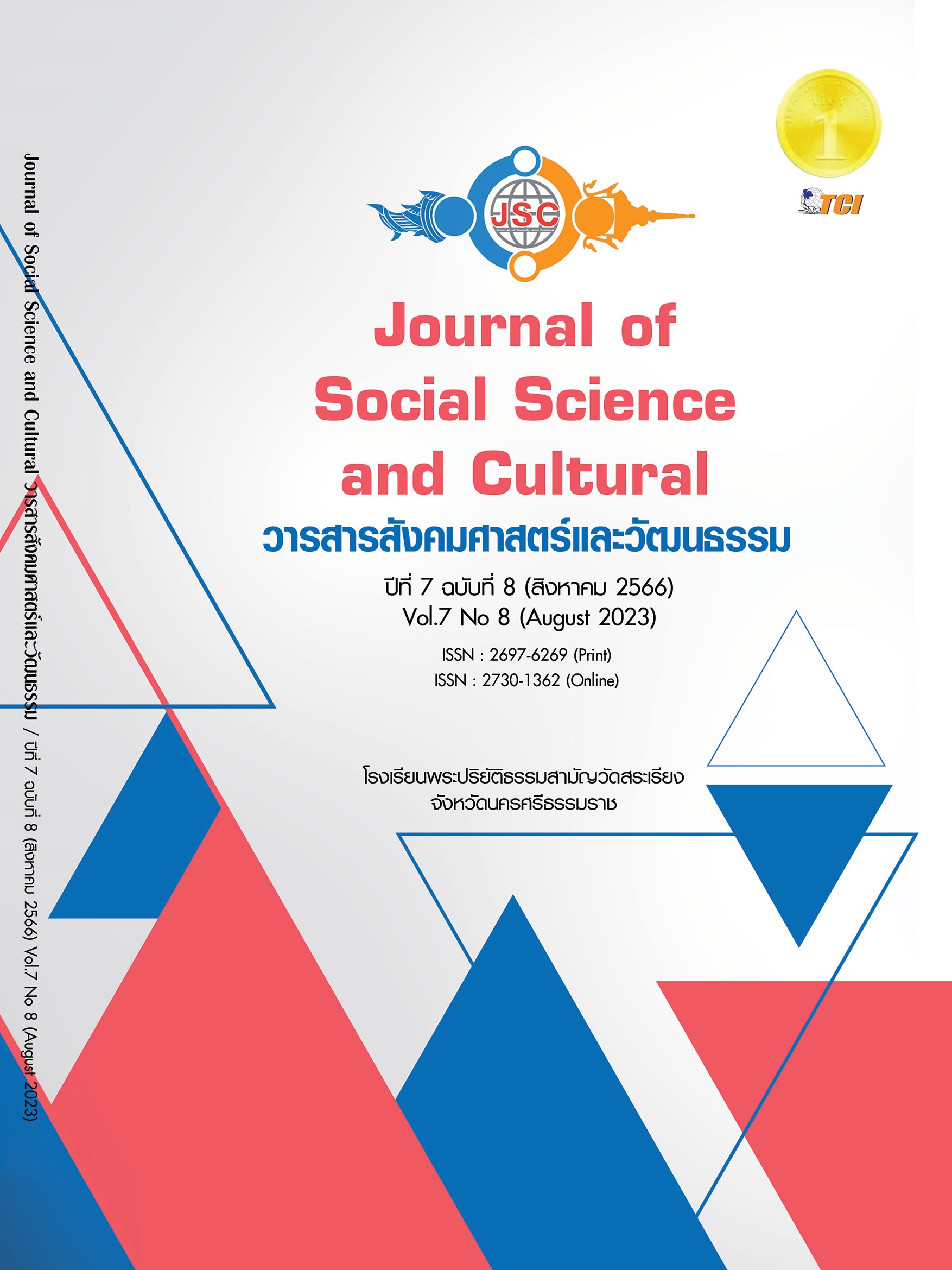THE PARTICIPATORY THAI ART EXHIBITION MODEL TO PROMOTE THE APPLICATION OF THAI ART IN DAILY LIFE FOR YOUTH
Main Article Content
Abstract
This research aimed to Develop the participatory Thai art exhibition model to encourage the use of Thai art in daily life. This research is Research and Development technique. There are 2 sample groups: The first group is used to study information to develop a participatory Thai art exhibition. These sample group are experts has been selected with purposive sampling method. Data were collected through interviews and observations of Thai art activities and participatory exhibitions. The second group was used to experiment with a participatory Thai art exhibition model, including 53 of 18 - 25 years old youths who visited the exhibition with and participated in the creative activities. 32 Participants were selected by voluntary selection. The tools used to collect data included commentary surveys on learning spaces of participatory Thai art exhibition, feedback surveys on creative Thai art activities in daily life, evaluation of the ability to apply Thai art. Data Analysis using mathematical averages, standard differences, and data analysis. The results of the research were a formation of a model for a participatory Thai art exhibition to promote the daily application of Thai art for young people. This research has developed the exhibition principles by using the learning management method according to the 4 MAT learning cycles. The exhibition consists of 2 parts: 1) is a learning area for participatory Thai art exhibitions. and 2) is the space for creative Thai art activities. The results of a participatory art exhibition experiment showed that young people had the highest level of opinion and satisfaction about the exhibition ( = 4.86, SD = 0.28). Young people had their highest levels of opinion, satisfaction with the art activities (
= 4.83, SD = 0.15). The evaluation of the work from the application of Thai art found that the average youth’s application of Thai art scores was very good, (
= 13, SD = 0.29)
Article Details
References
กระทรวงศึกษาธิการ. (2553). แนวทางนำภูมิปัญญาไทยเข้าสู่กระบวนการเรียนรู้นอกระบบโรงเรียนและการเรียนรู้ตามอัธยาศัย. กรุงเทพมหานคร: ชุมนุมสหกรณ์การเกษตรแห่งประเทศไทย.
กระทรวงศึกษาธิการ. (2560). หลักสูตรแกนกลางการศึกษาขั้นพื้นฐาน พุทธศักราช 2551. กรุงเทพมหานคร: โรงพิมพ์ชุมนุมสหกรณ์การเกษตรแห่งประเทศไทย.
กระทรวงศึกษาธิการ. (2563). สมองซีกขวามีค่ามากกว่าที่คิด. เรียกใช้เมื่อ 16 กันยายน 2564 จาก http://www.onec.go.th/index.php/book/BookView/1747
ณัฐกาญจน์ จันทน์เนื้อไม้. (2562). การพัฒนาชุดกิจกรรมการเรียนรู้เพื่อส่งเสริมการเห็นคุณค่าศิลปะล้านนา. ใน วิทยานิพนธ์มหาบัณฑิต สาขาวิชาศิลปศึกษา. จุฬาลงกรณ์มหาวิทยาลัย.
ธีติ พฤกษ์อุดม. (2560). การพัฒนากิจกรรมศิลปะเพื่อส่งเสริมการเห็นคุณค่าของอัตลักษณ์ในงานศิลปหัตถกรรมภาคใต้สำหรับเยาวชน. ใน วิทยานิพนธ์มหาบัณฑิต สาขาวิชาศิลปศึกษา. จุฬาลงกรณ์มหาวิทยาลัย.
นงนารถ ร่มเย็น และคณะ. (2561). ผลสัมฤทธิ์และความคิดสร้างสรรค์ของนักเรียนชั้นมัธยมศึกษาปีที่ 2 ที่ได้รับการจัดการเรียนรู้แบบ 4 MAT. วารสารวิชาการ มหาวิทยาลัยราชภัฏบุรีรัมย์ สาขามนุษยศาสตร์ และสังคมศาสตร์, 10(1), 81-95.
บังอร ศิริสัญลักษณ์. (2560). ทุนมนุษย์ของเจนเนอเรชั่นซีกับความพร้อมในการอยู่ร่วมในสังคมผู้สูงอายุ. วารสารการพัฒนาชุมชนและคุณภาพชีวิต, 5(1), 36-45.
ประเสริฐ ศีลรัตนา. (2549). การออกแบบนิทรรศการ (ฉบับกระเป๋า). กรุงเทพมหานคร: หจก. เอมี่ เทรดดิ้ง.
พิริยา สร้อยแก้ว และคณะ. (2562). ผลสัมฤทธิ์ทางการเรียนและความคงทนในการเรียนรู้ของนักเรียนชั้น ประถมศึกษาปีที่ 5 ที่ได้รับการจัดการเรียนรู้แบบ 4 MAT. วารสารครุศาสตร์, 47(1), 251-271.
วิจารณ์ พานิช. (2562). เป้าหมายของการเรียนรู้คือเปลี่ยนแปลงสมอง. เรียกใช้เมื่อ 23 กันยายน 2564 จาก https://thepotential.org/2019/11/11/vijarn-panich02/
ศรีเรือน แก้วกังวาล. (2549). จิตวิทยาพัฒนาการชีวิตทุกช่วงวัย. กรุงเทพมหานคร: มหาวิทยาลัยธรรมศาสตร์.
สำนักงานกองทุนสนับสนุนการสร้างเสริมสุขภาพ. (2557). สังคม 4 เจเนอเรชั่น. เรียกใช้เมื่อ 21 กันยายน 2564 จาก https://www. thaihealth.or.th/Content/24492-
สุภรัตน์ เบญญากาจ. (2562). แนวทางการจัดกิจกรรมศิลปะเพื่อส่งเสริมสันติวัฒนธรรมสำหรับเยาวชนไทย. วารสารอิเล็กทรอนิกส์ Veridian มหาวิทยาลัยศิลปากร, 12(5), 1173-1189.
อัจฉรา ทองพลาย. (2530). บทบาทของครูในการส่งเสริมวัฒนธรรมพื้นบ้านในโรงเรียนมัธยมศึกษา สังกัดกรมสามัญศึกษา เขตการศึกษา 6. ใน วิทยานิพนธ์มหาบัณฑิต สาขาวิชาสารัตถศึกษา. จุฬาลงกรณ์มหาวิทยาลัย.
Bernarduzz, L. F. . (2015). Cross Fertilization Between Museums and Schools, Science and Art, History and Multimedia. Journal Interchange, 46(1), 73-94.
Hoffding, S. . (2019). Participation and Receptivity in the Art Museum - A Phenomenological Exposition. Journal of Museum Education, 42(4), 376-384.
Huitt, W. (2009). Individual differences: The 4MAT system. In Educational Psychology Interactive. Valdosta: Valdosta State University.
McCarthy, B. (1980). The 4 MAT system: Teaching to learning styles with right/left techniques. Chicago: Excel.
Piaget, J. (1972). Intellectual evolution form adolescence to adulthood. Journal Human Development, 15(1), 1-12.


